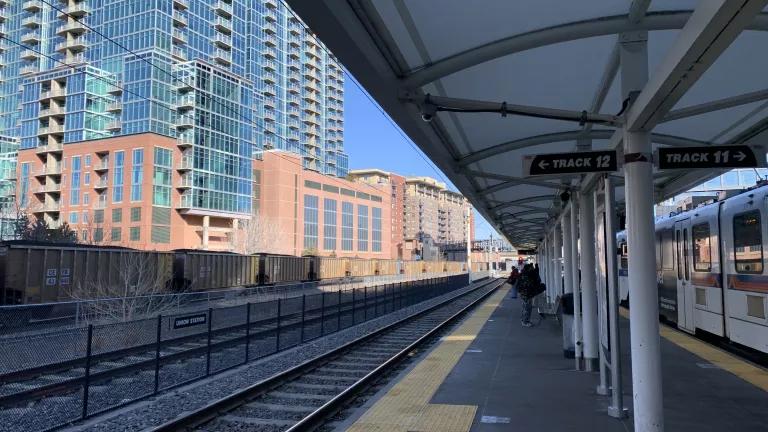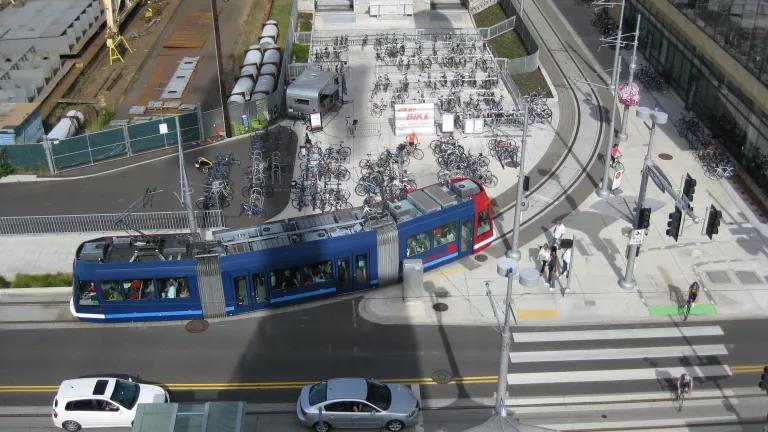Metro Charts New Course with 2028 Strategic Plan

Los Angeles County Metro dropped a draft strategic plan, Metro Vision 2028, last month, and on Monday May 7, you can join a stakeholder summit to chime in with comments. The goal of the new plan? Outlining the essential strategies for how Metro will implement an unprecedented investment in mobility at a time when L.A. has unprecedented mobility challenges.
Those challenges include rising congestion, flagging transit ridership, persistently high traffic injuries and fatalities, poor air quality, increasing greenhouse gas emissions, and unequal access to high-quality mobility options like rapid transit, ride-sharing and bikeable and walkable streets.
Whether Metro rises to the occasion can be judged in part by whether it understands those challenges, commits to relevant actions, and then follows through.
The voters of Los Angeles County have done their part, twice raising the city’s local sales tax a half percentage point since 2008 to bring in a total of $120 billion over the next two generations.
NRDC will be participating in the summit on Monday, and we hope you will, too, because the plan offers a refreshingly candid assessment of Metro’s challenges and outlines the necessary, albeit politically difficult, steps needed to make Metro an effective steward of sustainable and useful public mobility.
The Key Goal
The bottom line goal of the Vision 2028 plan is to “double the total usage of transportation modes other than driving alone, including transit, walk, bike, shared-ride and carpool modes” by 2028. The current breakdown of all trips in L.A. County is approximately 70-30 driving-alone compared to all other modes. Note that Metro’s goal is about doubling the total count of those non-drive-alone trips.
This is a stretch goal, but it’s the right scale of action given the urgency of our transportation challenges. Reaching this goal will require significant changes to how Metro operates and the political will to shepherd those changes onto our streets.
Need for Speed
One key metric where Metro service has deteriorated is bus speed, which has dropped to a systemwide average of 11 mph. That’s too slow if we’re truly going to provide high quality mobility to those already riding Metro buses, let alone try to chip away at that 70 percent of trips made today by a solo driver in a car.
Metro rightly focuses Vision 2028 on strategies to speed up buses, and even recognizes that doing so will require collaboration with and cajoling of the 89 localities in L.A. County (plus Caltrans) that control the surface streets and freeways on which Metro buses run. Historically Metro has been overly deferential to local jurisdictions on the question of priority for buses on city streets, which is why I was excited to see this in the plan:
We will collaborate with municipal partners and other transit operators to dedicate the resources necessary to reclaim street space in order to maximize people throughput over vehicle throughput. Exclusive lanes will be assigned to high capacity vehicles, and passengers who are willing to share rides will be rewarded. Metro will also take a more aggressive approach to identifying and mitigating congestion hot spots that inhibit faster transit operating speeds on the network. In sum, we will work to vastly reduce trip times for bus passengers by finding ways to move buses swiftly through congested areas.
The plan outlines steps to accomplish this including implementing signal priority, queue jumps, and bus lane enforcement to get Rapid Buses up to 18 mph in the next five years. The following five years will see Metro convert key Rapid Bus lines into full fledge Bus Rapid Transit.
Managing Supply and Demand on Scarce Roads
Another bold move includes a commitment to “test and implement pricing strategies to reduce traffic congestion.” Cities like London and Stockholm have used driver financial incentives to manage congestion since the 2000s and reaped significant benefits in reduced congestion, cleaner air and faster and busier transit.
Responsible Partner and Neighbor
The strategic plan also sets appropriate goals with respect to Metro’s role as a major employer and community presence in Los Angeles.
Some highlights include:
- Developing and retaining affordable housing near transit stations
- Incorporating genuine community engagement
- Encouraging municipal partners to adopt transit-supportive land use policies, including parking, urban design, and housing regulations that are conducive to transit usage
- Managing financial resources prudently to ensure public investment leads to maximum benefits for the public
- Creating a diverse and inclusive workforce
- Supporting avenues for small businesses to work with Metro
What’s Missing?
Zero emissions: While Metro has committed to a fully electric bus fleet by 2030, the strategic plan is lacking details on the substantial steps the agency will need to take to achieve a fully zero-emissions transit system, including procuring new buses, rebuilding bus yards and training its workforce. A zero emissions Metro is especially important for Metro riders, who disproportionately live in neighborhoods that are burdened by air pollution.
Autonomous vehicles: What is Metro’s role in our shared and autonomous mobility future? The strategic plan indicates Metro will engage with partners and enforce policies to shape how AVs operate, but the plan is silent on how self-driving vehicles could alter Metro’s own operations. Self-driving buses could on one hand allow Metro to offer substantially cheaper and more abundant bus service, but that shouldn’t come at the expense of well-paying transit jobs. Now is the time for Metro leadership to begin planning for an autonomous future that empowers its workforce and continues to provide pathways to good careers in the transit industry.
Bottom Line
This paragraph from the Vision 2028’s conclusion really cuts to the heart of the issue:
To successfully and sustainably meet the transportation needs of LA County in the decades to come, existing resources must be used more effectively. The current system is inefficient: limited street space is largely given over to single-occupancy vehicles, which are too often stuck in traffic, while the most disadvantaged members of our community are confined to a patchwork of transportation options that frequently fail to meet their basic mobility needs. Changing this state of affairs is central to transforming LA County into a happier, more vibrant, more prosperous, and more equitable place to live and work.
Whether Metro is successful at reshaping the status quo on our streets will come down to sustained commitment from the agency’s Board of Directors and executive team, working alongside advocates on the ground. Metro is making crystal clear what needs to be done to make L.A.’s transportation system more sustainable, healthy and equitable—and to help our county be more livable for us all.




